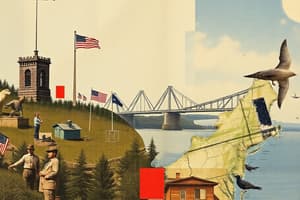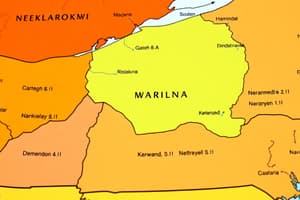Podcast
Questions and Answers
What natural feature has influenced the economy of the Northeast most significantly?
What natural feature has influenced the economy of the Northeast most significantly?
- The Great Lakes
- The Appalachian Mountains (correct)
- The Rocky Mountains
- The Mississippi River
Which resource is notably found in Pennsylvania, contributing to the Northeast's economy?
Which resource is notably found in Pennsylvania, contributing to the Northeast's economy?
- Natural gas
- Coal (correct)
- Timber
- Iron ore
How did the Northeast become a leader in industry?
How did the Northeast become a leader in industry?
- By establishing numerous coal mines.
- By having vast mineral resources.
- By exporting agricultural products
- By harnessing water power using rivers. (correct)
What role did rivers play in the industrial development of the Northeast?
What role did rivers play in the industrial development of the Northeast?
What distinguishes the Northeast coastal region in terms of urban development?
What distinguishes the Northeast coastal region in terms of urban development?
What aspect of the Northeast has attracted millions of visitors annually?
What aspect of the Northeast has attracted millions of visitors annually?
Which of the following statements is true about the Northeast's natural resources?
Which of the following statements is true about the Northeast's natural resources?
What was a major factor that aided early industrialists in harnessing water power in the Northeast?
What was a major factor that aided early industrialists in harnessing water power in the Northeast?
What natural resource attracted early European immigrants to the South?
What natural resource attracted early European immigrants to the South?
Which of the following reasons contributed to the South attracting businesses in recent decades?
Which of the following reasons contributed to the South attracting businesses in recent decades?
In the 1840s, where were many textile mills built?
In the 1840s, where were many textile mills built?
Which area was known for the concentration of textile mills in the 1840s?
Which area was known for the concentration of textile mills in the 1840s?
What major industry brought great wealth to the South after the discovery of oil in east Texas?
What major industry brought great wealth to the South after the discovery of oil in east Texas?
What factor contributes significantly to the agricultural productivity of the Midwest?
What factor contributes significantly to the agricultural productivity of the Midwest?
Which region overlaps with the South and extends to California?
Which region overlaps with the South and extends to California?
What technology was pioneered by Cyrus McCormick that transformed farming?
What technology was pioneered by Cyrus McCormick that transformed farming?
What factor contributed to the lower labor costs in the South compared to other regions?
What factor contributed to the lower labor costs in the South compared to other regions?
Which economic activity is most dominant in the Midwest?
Which economic activity is most dominant in the Midwest?
What was a significant characteristic of the population in the South?
What was a significant characteristic of the population in the South?
In what way have American farms changed over time?
In what way have American farms changed over time?
What economic activity remained important to the South's economy?
What economic activity remained important to the South's economy?
Which characteristic of the Midwest climate is most favorable for agriculture?
Which characteristic of the Midwest climate is most favorable for agriculture?
Which factors played a significant role in the growth of heavy industry in the Midwest?
Which factors played a significant role in the growth of heavy industry in the Midwest?
Which state is identified as a leader in iron ore production?
Which state is identified as a leader in iron ore production?
What name is commonly given to the Midwest due to its agricultural output?
What name is commonly given to the Midwest due to its agricultural output?
What is the largest grain exchange in the United States?
What is the largest grain exchange in the United States?
How are large Midwestern cities related to agriculture?
How are large Midwestern cities related to agriculture?
How has the growth of the railway system influenced the Midwest's economy?
How has the growth of the railway system influenced the Midwest's economy?
Where are many major cities in the Midwest located?
Where are many major cities in the Midwest located?
What has significantly reduced the number of farm workers in the Midwest?
What has significantly reduced the number of farm workers in the Midwest?
What natural resource is found in significant deposits in Indiana and Illinois?
What natural resource is found in significant deposits in Indiana and Illinois?
What type of climate characterizes much of the West?
What type of climate characterizes much of the West?
Which of the following regions is noted for having dense tropical vegetation?
Which of the following regions is noted for having dense tropical vegetation?
What transformed Alaska's economy in the 1960s?
What transformed Alaska's economy in the 1960s?
What natural resources attracted prospectors to the West during the 1800s?
What natural resources attracted prospectors to the West during the 1800s?
What does the term megalopolis refer to?
What does the term megalopolis refer to?
What infrastructure was developed to support water needs in Los Angeles?
What infrastructure was developed to support water needs in Los Angeles?
What is a significant concern regarding the east coast megalopolis?
What is a significant concern regarding the east coast megalopolis?
How did hilly terrain and high precipitation benefit the Atlantic coastal region?
How did hilly terrain and high precipitation benefit the Atlantic coastal region?
Which feature of western cities contributed to their growth after the 1860s?
Which feature of western cities contributed to their growth after the 1860s?
Why is Alaska noted for its sparse population?
Why is Alaska noted for its sparse population?
By the 1960s, how had the coastal cities of the Northeast changed?
By the 1960s, how had the coastal cities of the Northeast changed?
Which of the following best describes the natural vegetation of the tundra in Alaska?
Which of the following best describes the natural vegetation of the tundra in Alaska?
What is a characteristic vegetation found in the southern climate?
What is a characteristic vegetation found in the southern climate?
What are bayous primarily associated with in Louisiana?
What are bayous primarily associated with in Louisiana?
Which factor contributed to the growth of cities in the South?
Which factor contributed to the growth of cities in the South?
What was one effect of the spread of coastal cities on the Atlantic coast?
What was one effect of the spread of coastal cities on the Atlantic coast?
Flashcards
Northeast's Physical Characteristics
Northeast's Physical Characteristics
The Northeast is known for its diverse geography including the rugged Appalachian Mountains and its coastline.
Northeast's Resources
Northeast's Resources
The Northeast has limited natural resources, particularly minerals, with coal in Pennsylvania being a notable exception.
Northeast's Economic Importance
Northeast's Economic Importance
The Northeast has a long history of commerce and fishing, dating back to colonial times.
Northeast's Rivers' Significance
Northeast's Rivers' Significance
Signup and view all the flashcards
Northeast's Industrial Growth
Northeast's Industrial Growth
Signup and view all the flashcards
Northeast's Industrial Products
Northeast's Industrial Products
Signup and view all the flashcards
Northeast's Trade Routes
Northeast's Trade Routes
Signup and view all the flashcards
Northeast's Industrial Hub
Northeast's Industrial Hub
Signup and view all the flashcards
Midwest's dominant economic activity
Midwest's dominant economic activity
Signup and view all the flashcards
Factors for heavy industry growth
Factors for heavy industry growth
Signup and view all the flashcards
What is the Chicago Board of Trade?
What is the Chicago Board of Trade?
Signup and view all the flashcards
How does water affect vegetation in the West?
How does water affect vegetation in the West?
Signup and view all the flashcards
What natural resources drive the Western economy?
What natural resources drive the Western economy?
Signup and view all the flashcards
How do geography and distance influence Western settlement?
How do geography and distance influence Western settlement?
Signup and view all the flashcards
Water's Impact
Water's Impact
Signup and view all the flashcards
Western Climate
Western Climate
Signup and view all the flashcards
Western Mountains
Western Mountains
Signup and view all the flashcards
Hawaii's Climate
Hawaii's Climate
Signup and view all the flashcards
Alaska's Tundra
Alaska's Tundra
Signup and view all the flashcards
Western Minerals
Western Minerals
Signup and view all the flashcards
Megalopolis
Megalopolis
Signup and view all the flashcards
Alaska's Oil
Alaska's Oil
Signup and view all the flashcards
What is a megalopolis?
What is a megalopolis?
Signup and view all the flashcards
How did hilly terrain and high precipitation benefit the region?
How did hilly terrain and high precipitation benefit the region?
Signup and view all the flashcards
Western Economy
Western Economy
Signup and view all the flashcards
Bayous
Bayous
Signup and view all the flashcards
How do warm climate and rich soils impact vegetation in the South?
How do warm climate and rich soils impact vegetation in the South?
Signup and view all the flashcards
What key natural resources influenced Southern industrial development?
What key natural resources influenced Southern industrial development?
Signup and view all the flashcards
How have changes in the South led to the growth of cities there?
How have changes in the South led to the growth of cities there?
Signup and view all the flashcards
What are the concerns about the future of the megalopolis?
What are the concerns about the future of the megalopolis?
Signup and view all the flashcards
Rich Soil in the South
Rich Soil in the South
Signup and view all the flashcards
Southern Agriculture
Southern Agriculture
Signup and view all the flashcards
Appalachia's Poverty
Appalachia's Poverty
Signup and view all the flashcards
Fall Line Textile Mills
Fall Line Textile Mills
Signup and view all the flashcards
Texas Oil Boom
Texas Oil Boom
Signup and view all the flashcards
Southern Industrial Growth
Southern Industrial Growth
Signup and view all the flashcards
Sunbelt Region
Sunbelt Region
Signup and view all the flashcards
Southern Diversity
Southern Diversity
Signup and view all the flashcards
Appalachia
Appalachia
Signup and view all the flashcards
The Bayou
The Bayou
Signup and view all the flashcards
The Fall Line
The Fall Line
Signup and view all the flashcards
The Sunbelt
The Sunbelt
Signup and view all the flashcards
What natural resource attracted early European immigrants to the South?
What natural resource attracted early European immigrants to the South?
Signup and view all the flashcards
What area were many textile mills built in the 1840s?
What area were many textile mills built in the 1840s?
Signup and view all the flashcards
How does the Midwest's climate support agriculture?
How does the Midwest's climate support agriculture?
Signup and view all the flashcards
Why has farming become big business in the Midwest?
Why has farming become big business in the Midwest?
Signup and view all the flashcards
Study Notes
Chapter 7: Regions of the United States
- The chapter explores four regions of the United States: The Northeast, The South, The Midwest, and The West.
- Each section investigates the factors affecting the region.
Section 1: The Northeast
- Physical characteristics and resources: How have the physical characteristics and resources of the Northeast affected its economy?
- Early industrial leader: How did the Northeast become an early leader of industry?
- Megalopolis: Why has the Northeast coastal region become a megalopolis?
Section 2: The South
- Climate and vegetation: How have warm climate and rich soils affected vegetation in the South?
- Natural resources: What key natural resources have influenced industrial development?
- Urban growth: How have changes in the South led to the growth of cities there?
Section 3: The Midwest
- Climate and agriculture: How does the climate of the Midwest support agriculture?
- Farming as business: Why has farming become big business?
- Industry and transportation: How have resources and transportation promoted industry in the Midwest?
Section 4: The West
- Water and vegetation: How does the abundance or scarcity of water resources affect natural vegetation in the West?
- Natural resources and economic activity: What major natural resources have influenced economic activity in the Western United States?
- Geography and population: How have geography and distance affected where people live and work in the region?
Studying That Suits You
Use AI to generate personalized quizzes and flashcards to suit your learning preferences.
Related Documents
Description
This quiz covers Chapter 7, which explores the four main regions of the United States: The Northeast, The South, The Midwest, and The West. Each section examines the geographical, economic, and historical factors that shape these areas. Test your knowledge of the unique characteristics that define each region.




